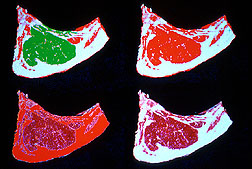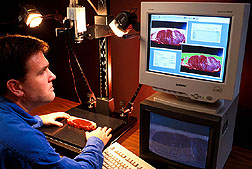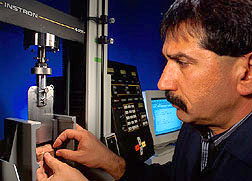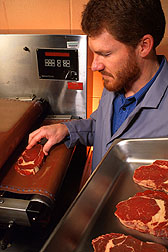Predicting Tenderness in Beefsteaks
|
|
A savvy supermarket shopper may moderately improve the odds of picking the New York strip steak that will cook up most tender and tasty by choosing one well marbled with tiny flecks of fat. But guessing isn't the best way to buy food. Just ask anybody who, sitting at a nice restaurant, has bitten into a scrumptious-looking steak and found it surprisingly tough.
Now guesswork is on the way out—at least when it comes to meat tenderness. Agricultural Research Service scientists have developed a sampling, cooking, and testing system that will, with about 94 percent accuracy, pick out beef carcasses that will yield loin and rib cuts of above-average tenderness. Since 1997, at least five meat-processing companies have been considering adoption of the system, which was developed at the Roman L. Hruska U.S. Meat Animal Research Center (MARC) in Clay Center, Nebraska.
Under the system protocol, a rib steak is taken from a chilled carcass, trimmed, and cooked, says ARS animal physiologist Mohammad Koohmaraie, who heads the MARC Meats Research Unit. Then a sample of the beef is sheared and measured for tenderness with an electronic testing machine that supplies data to a computer.
|
|
In the past year, the researchers have added a new feature to the system: a computerized image analysis of the 1-inch-thick ribeye steak to provide an estimate of how many pounds of retail beef the carcass will yield after bones are removed and fat is trimmed.
Small and mid-sized beef packers could easily adapt this technology to their normal operations. Further automation would allow high-volume operations to run up to 400 carcasses per hour without interfering with standard carcass processing rates, Koohmaraie says.
Randal Garrett, a North Kansas City (Missouri) entrepreneur who is now forming a meat-processing company, emphasizes the need for smooth product flow rates in new or renovated plants, if tenderness classification is used. He says the MARC system, based on excellent research, stands its best chance of widespread adoption if consumers generally become aware that tough and tender cuts now exist in every grade and if standard tenderness measurements can be achieved smoothly within the grading system.
What's Standard Practice
Packing plants routinely cool carcasses for up to 3 days after slaughter. Then, after the brief yield and quality grade classification, the carcasses are processed into cuts. The MARC tenderness classification system, also applied 3 days after slaughter, offers an alternative for segments of the industry that market name-brand products. The system would enable meat packers to accurately segregate the carcasses into groups according to their expected tenderness. Plans could then be made to market the carcasses at commensurate prices.
|
|
MARC scientists and their collaborators have conducted a series of experiments to determine the value of tenderness to consumers. Public and private grants obtained through the Research Institute on Livestock Pricing at Virginia Polytechnic Institute and State University at Blacksburg, Virginia, partly funded the most recent of these studies. A summary will be posted on the World Wide Web in February 2000.
A portion of the study—a blind taste test—showed that 36 percent of consumers were willing to pay an average $1.23 per-pound premium for a tender steak. And they were willing to pay a $1.84 premium if they had been informed the same steak was rated as tender.
The study, which also considered the costs of measuring tenderness and of sorting, labeling, and pricing products, concluded that marketing beef with tenderness labels would be economically feasible.
Consumers who like their steaks cooked until they're medium to very well done would most welcome tender-rated beef. "Generally, ribeye steaks become tougher when cooked more well done, but we've found the effect is less severe for ribeye steaks classified as tender," says ARS food technologist Tommy L. Wheeler, who is based at MARC.
|
|
Many tender and palatable carcasses are currently discounted in value because they have insufficient marbling fat to be graded as USDA Choice or higher, says Koohmaraie. Yet, sensory panel research at MARC shows marbling accounts for only about 10 percent of variation in beef ribeye tenderness.
Just as the MARC classification system may make beef pricing more rational as it moves from meatpacking plants to supermarkets, it may even improve marketing efficiency and production back down on the farm. Live animals with tags or some other form of identification can be matched with data from the computerized image analysis. The information can be conveyed to feedlot managers, helping them better master efficient ways to produce quality beef that's tender but not overly fat.
"We've found that leanness of a carcass has little relationship with beef ribeye tenderness," says MARC food technologist Steven D. Shackelford.
The computer data can also be conveyed to cattle breeders who are trying to improve the genetics of their herds. Dave Nichols, a cattle breeder near Bridgewater, Iowa—citing present farm economic problems— says people in the cattle industry are becoming more committed to satisfying consumers' desires for beef that's predictably tender.
About 30 percent of the variation in beef ribeye tenderness can be ascribed to heredity, which may involve expression of many genes, Koohmaraie says. The remaining 70 percent of the variation in tenderness is controlled by nongenetic factors.
Because each gene's contribution is minor compared to confounding environmental factors, identifying desired gene combinations for tenderness would have been a nearly impossible task when scientists were limited to classical inheritance studies. But now MARC scientists have developed a cattle genome map and are refining it to make the task doable.—By Ben Hardin, Agricultural Research Service Information Staff.
The research is part of Animal Production Systems, an ARS National Program (#102) described on the World Wide Web at http://www.nps.ars.usda.gov/programs/appvs.htm.
Mohammad Koohmaraie and other scientists (Tommy L. Wheeler, Steven D. Shackelford) mentioned in this article are at the Roman L. Hruska U.S. Meat Animal Research Center, P.O. Box 166, State Spur 18D, Clay Center, NE 68933; phone (402) 762-4222, fax (402) 762-4149.
"Predicting Tenderness in Beefsteaks" was published in the November 1999 issue of Agricultural Research magazine.










